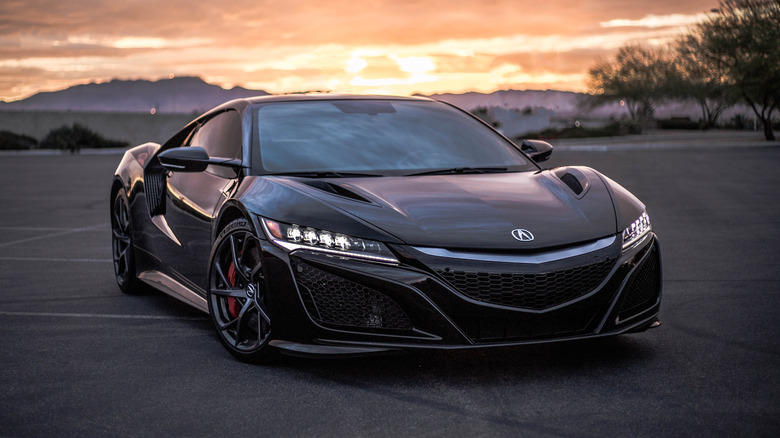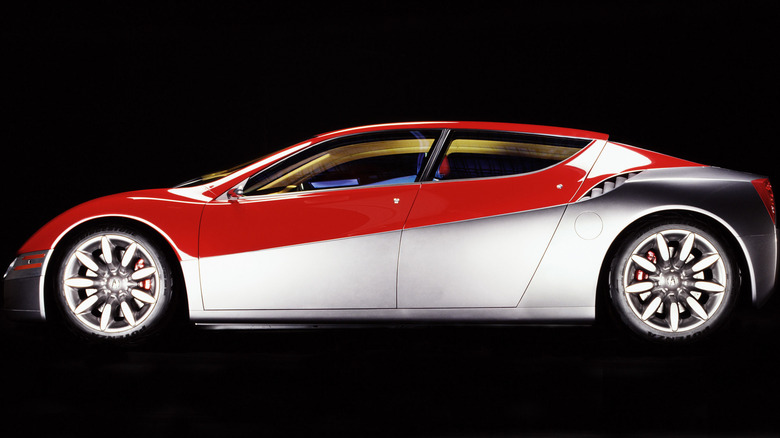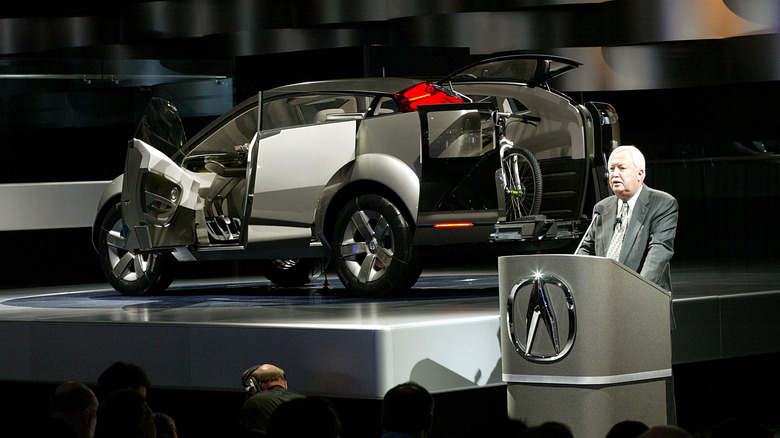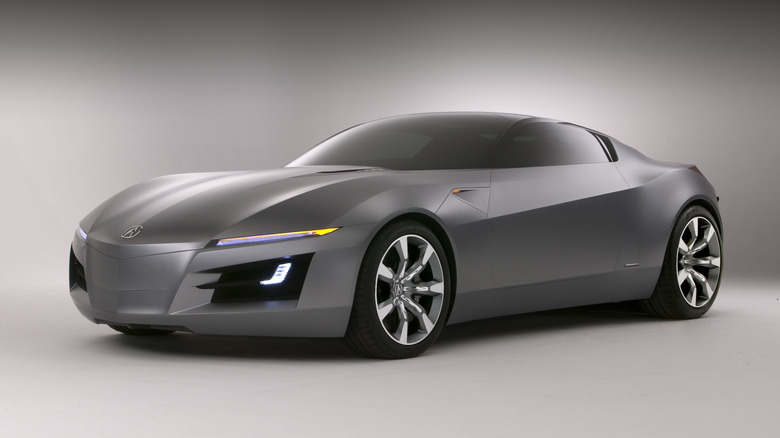5 Acura Concept Vehicles We Wish It Would Have Built
A good concept vehicle's goal is to showcase some snazzy new tech, like the array of driver assistance systems we see in most new cars today. Perhaps it's to wow the public (and get valuable feedback) with new styling or the use of new materials with which the automobile is actually built.
Concept cars are, as Acura described it when talking about its performance Precision EV concept, "a design study that will shape the direction of future Acura products." It's a sentiment backed by other automakers and designers, who consider these one-offs as a means to test out new ideas and — dare we say — concepts and technologies that, if proven successful, will see accelerated and continued development into a fully produced line of cars.
These prototypes are never meant to be sold to the general public, and once they've made the rounds of the global show circuit, are destroyed, parked in storage to gather dust somewhere, or placed in car museums. Over the years, Acura has produced a few dozen different concept cars. Here are five of those we wish it would have moved into full production because there are some seriously sweet rides on this list.
2002 DN-X
The Acura DN-X debuted in North America at the 2002 New York International Auto Show, and it was nothing short of a dazzler. Despite having four doors and being technically listed as a sports sedan, it was all about Acura's racing heritage and engine technology leading the way for this concept.
When was the last time you saw a mid-engine mounted in a sedan? Exactly. The all-wheel-drive DN-X rocked a high-output 3.5-liter, DOHC, i-VTEC V6 that produced 400 horsepower. But that's not all. While the V6 spun the rear wheels, the unique hybrid powertrain with advanced electric Integrated Motor Assist (IMA) drove supplemental power to all wheels, allowing it to get 42 miles to the gallon. The DN-X was equipped with an interesting transmission setup that gave the driver options. It could either be slipped into manual, simulating a clutchless 6-speed manual, with shifter controls on the high-tech Formula One-styled steering wheel, or into a fully automatic mode.
The DN-X had all the bells and whistles: Intelligent driver support features that included lane-keeping assistance, adaptive cruise control, vehicle stability assist, and an active torque transfer system. These features were also evident inside the cabin, including interactive voice recognition, GPS navigation, and a pop-up display providing e-mail, Internet, and cell phone service. Oh, it also had a night vision system. Come on, you're thinking David Hasselhoff's Knight Rider K.I.T.T. car, aren't you? Remember that this was back in 2002 when many of these features weren't even part of the English vocabulary yet.
2002 RD-X
The homogenized version of the RD-X rolling through the streets today looks nothing like the concept shown 20-something years ago. This SUV was wholly designed and developed by Honda R&D in America that took the street performance of the RSX sports coupe and slapped the 4-wheel drive capability of an MDX onto it.
It was equipped with a 2.4-liter, 16-valve, DOHC, i-VTEC 4-cylinder main engine banging out 250 horsepower that drove the front wheels, while an Integrated Motor Assist with twin electric motors powered the rear wheels. This was mated to a Honda Formula One-inspired 6-speed, close-ratio clutchless manual transmission manipulated by paddle shifters on the center console. The 2+2 design sat four, but the mesh fold-away rear seats could be stowed to make room for almost every adventure toy. To that end, the back doors slid to the sides like an elevator for cargo loading, which would come in handy in the city where parallel parkers inevitably get too close to pop the rear hatch.
The cabin was equipped with much of the same technology found in the DN-X and looked like something Batman would drive. It had a futuristic steering "wheel" and virtual HUD (heads-up display) that projected all the essential data (i.e., speed, RPM, fuel, oil, etc.) onto the windshield. The entire "dashboard" (for lack of a better term) could be moved and adjusted based on the driver's personal preferences. The rear passenger doors opened suicide-style.
If Acura had built this version of the RD-X, it would indeed have had a blockbuster.
2003 Acura High-Performance Sports Concept
The HSC was supposed to be the next NSX. It first popped up in 2003 at the Tokyo Motor Show labeled as a "Honda Sports Concept." Still, when it appeared at the North American International Auto Show in Detroit in early 2004, it had been rechristened as the Acura High-Performance Sports Concept. Whatever the terminology, it was designed around the concept of building a supercar with a comfortable interior that could be driven as a daily commuter. It never came to fruition, though.
Powered by a naturally aspirated (no turbocharger here) 3.5-liter V6 mid-mounted engine, it was expected to produce over 300 horsepower. Coupled with a body made from aluminum and carbon fiber panels atop an all-aluminum frame, it would have made it super lightweight and provided superior handling and performance. Estimates pegged a zero to 60 time of 4.7 seconds, with a top speed of around 186 miles per hour.
Interestingly, the HSC was fitted with cameras instead of usual mirrors, including one mounted on the back near the taillights that showed a view behind the car on the navigation system's tilt-up screen. The driver was given two shifting modes, either with a dial shifter on the center console or via a Formula One-style paddle shifter (which 33% of people think is the most pointless feature in a car) capable of instantaneous gear changes on the steering wheel — all cool concepts, to be sure.
2007 Advanced Sports Car Concept
The profile of the Advanced Sports Car Concept (ASCC) Acura revealed in 2007 looks strikingly similar to that of today's Nissan Z, albeit slightly longer, wider, and lower. It also looked similar to Maserati's 4200 GT coupe, which wasn't a bad thing considering Maserati's prestige. The ASCC was meant to give the public a peek at the next generation of its exotic sports cars, and the fact that a vehicle from 2024 — built by a different manufacturer, no less — has similar body lines tells us Acura's design team hit a home run. This concept took some not-so-subtle styling cues from the NSX, which still wasn't even two years removed from the end of its production life.
A massive V10 engine sat under the elongated front hood. Estimates put the displacement between 4.5 and 5.5 liters, producing approximately 500 horsepower (give or take a few horses). This beast powered the low-slung 48.1-inch high car, and the ASCC was equipped with Acura's exclusive Super Handling All-Wheel Drive. The car's cabin was made entirely of tinted glass, while the underbody was made from carbon fiber. Front LED headlights sat wide, resembling the pop-ups on the first NSX. Sculpted lines ran all over the body, down the car's sides through the doors (with flush-mounted handles) to wraparound rear taillights. Ventilated carbon ceramic brake discs and eight-piston calipers adorned the custom billet-machined, polished aluminum wheels wrapped with 19-inch front and 20-inch rear performance tires.
Consider us wild for this concept!
2009 Mugen NSX RR Concept
In the fall of 2009, an NSX concept appeared at the Tokyo Motor Show that was a smash hit with both showgoers and assembled press alike. And it was unlike any other street-legal car, let alone NSX, that had come before. As the buzz increased even after the show, as might be expected, rumors began to run rampant about a limited production run. Unfortunately, that's as far as things went, leaving this lone concept as the only tangible evidence that such a masterpiece from the famed Mugen tuner shop ever existed.
Mugen started with a chassis from a GT500, the same car used in the Super GT series and one it was intimately familiar with since it tuned most of Acura's racing vehicles. It also took its middle section and then slapped customized aluminum space frames on either end. The Mugen RR Concept body kit — painted in Honda racing's Grand Prix White — had a front bumper with a carbon air dam, flared front and rear fender covers, vented hood, and carbon-fiber side skirts. Sitting on the back deck above the wide rear bumper (complete with mesh exhaust cutouts and diffuser) was an enormous adjustable spoiler with an inserted LED brake light (for safety's sake).
Under the hood sat a longitudinally-mounted 3.2-liter naturally-aspirated C32B V6 engine with the pièce de résistance – a carbon-fiber "snorkel" air intake roof scoop that fed air directly through the back window into the exposed mid-mounted engine.
If these Acura concepts don't tingle your Spidey senses ... chances are nothing will.



